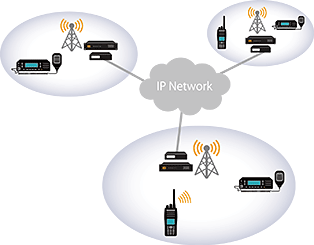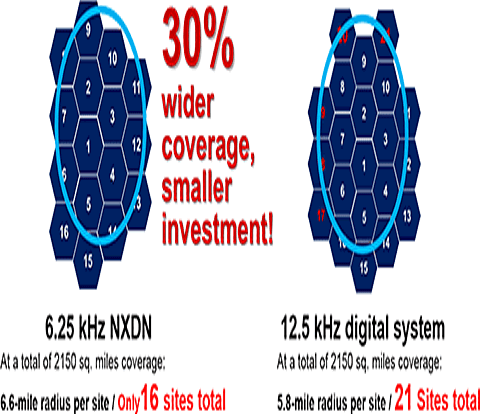Scalability
As well as traditional conventional systems, conventional IP networks and trunked networks, NEXEDGE® allows you to link up to 1,000 sites (up to 24 networks).
Digital Conventional Systems
 NEXEDGE® conventional systems offer capabilities superior to those of analog conventional systems. With large unit ID and talk group ID capacity, operators can identify and segment different departmental/agency groups and sub-groups on shared channels. Also, Mixed Mode allows service to both analog and digital fleets at the same time.
NEXEDGE® conventional systems offer capabilities superior to those of analog conventional systems. With large unit ID and talk group ID capacity, operators can identify and segment different departmental/agency groups and sub-groups on shared channels. Also, Mixed Mode allows service to both analog and digital fleets at the same time.
- RAN (Radio Access Number)
Base units include a 16 RAN capacity conventional repeater controller for 16 user group site sharing (RAN range: 1-64); this is similar to CTCSS/DCS use in FM.
- 1,000 GIDs
Large talk group ID capacity for group selective calling
- 1,000 UIDs
Large unit ID capacity for individual selective calling
- Mixed Channel Type
FM & NXDN™ conventional units can share the same RF channel. Both subscriber units and bases demodulate incoming analog FM or NXDN™ digital calls and talkback/repeat in the same mode (conventional channels only, with 12.5 kHz narrow bandwidth).
Digital Conventional IP Networks
 NEXEDGE® conventional IP networks offer wide area coverage or coverage fill-in extensions.
NEXEDGE® conventional IP networks offer wide area coverage or coverage fill-in extensions.
- 16 or 48 Site* Configurations
NEXEDGE® conventional IP networks link up to 16 or 48 digital conventional repeaters into one system for wide area coverage or to provide coverage fill-in extensions.
- Beacon Signals
As users roam through the network, subscriber units use the beacon signals to choose the best repeater.
- Normal or Automatic Site Roam (per Zone)
Subscriber zones can be programmed for “Normal Channel Select” for traditional conventional operation, and/or “Automatic Site Roam,” which allows subscribers to scan for site beacon signals to lock on to for network calls.
- Receiver Voting
Voting systems extend the portable talk-in range of a NXR-710/810 conventional repeater by utilizing a constellation of satellite receivers linked to the repeater site. Based on portable signal strength data (RSSI) sent via IP link, the repeater site selects the receiver site with the best audio quality for re-transmission.
NXDN™ Type-C Trunking
 NEXEDGE® Type-C trunking provides increased capacity, enhanced call capabilities, improved security and faster communications with less user interaction than conventional systems. The system automatically assigns channels for faster, efficient use of spectrum, allowing users to concentrate on the job at hand.
NEXEDGE® Type-C trunking provides increased capacity, enhanced call capabilities, improved security and faster communications with less user interaction than conventional systems. The system automatically assigns channels for faster, efficient use of spectrum, allowing users to concentrate on the job at hand.
- System Call Queuing
Stacks call requests and processes calls when a channel becomes available. System operators can assign higher queue priority to certain users and pre-empt lower priority users for more important dispatch and emergency calls.
- Priority Monitor
Monitors for up to 4 high priority talk groups and automatically switches radios to a higher priority call, such as from a dispatcher or supervisor.
- Privacy
Group and individual calls enjoy complete privacy as other users in the system cannot monitor the calls.
- Late Entry
Subscriber units may join a group or individual call already in progress after powering on or upon entering the system coverage area.
- Message Trunking
Users are granted a traffic channel for the length of a two-way call to reduce interruptions by utilizing less system resources.
- Transmission Trunking
Users are granted a traffic channel only during each push-to-talk, optimizing channel resources during peak traffic hours.
-
NXDN™ Type-D Trunking
This is the FB6*-based digital LTR protocol specified by the NXDN™ Forum. Unlike Type-C trunking, there is no dedicated control channel: trunking is under the control of the home repeater assigned to each radio. And like LTR, there is no registration.
*FCC Station Class Codes
Extended Coverage
 As RF signal strength weakens with distance, analog reception becomes increasingly noisy and intermittent. The low BER of NXDN™ improves reception in fringe areas, thereby effectively increasing range by as much as 20% over FM analog, resulting in a 50% increase in coverage area for digital 6.25 kHz.
As RF signal strength weakens with distance, analog reception becomes increasingly noisy and intermittent. The low BER of NXDN™ improves reception in fringe areas, thereby effectively increasing range by as much as 20% over FM analog, resulting in a 50% increase in coverage area for digital 6.25 kHz.
Furthermore, even compared to digital 12.5 kHz bandwidth operation, the narrower 6.25 kHz bandwidth enabled by the FDMA technology of NXDN™ extends range by 15%. Receiver filters are narrower and can thus reduce noise. The net result is superior clarity over a 30% wider coverage area.